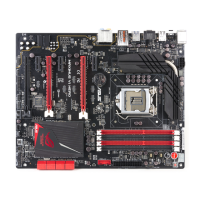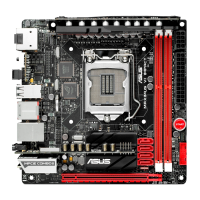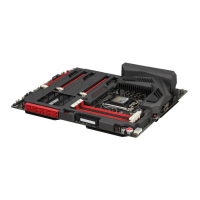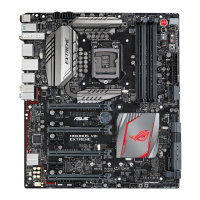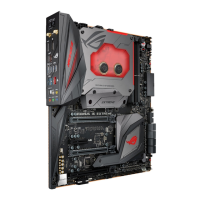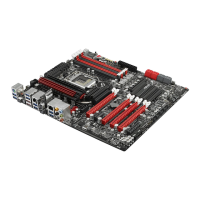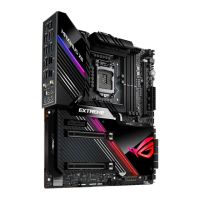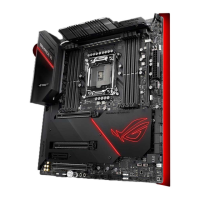Do you have a question about the Asus Maximus VI Extreme and is the answer not in the manual?
Precautions for preventing electrical shock hazards during system operation and component handling.
Guidelines for safe installation and handling of motherboard components and peripherals.
Details on the supported CPU socket and processor generation.
Specifications for DDR3 memory architecture, slots, and supported speeds.
Information on PCI Express and mini-PCIe slots for add-on cards.
Details on SATA ports, M.2 slot, and storage controllers.
Specifications for USB 2.0 and USB 3.0 ports and controllers.
List of exclusive features and technologies for ROG motherboards.
Details about the OC Panel's LCM display and its capabilities.
Overview of OC Panel features, including OC modes and ROG exclusive functions.
Description of the power and fan connectors on the OC Panel.
List of essential tools needed for motherboard installation.
List of necessary PC components for system assembly.
Overview of unique features and technologies of the motherboard.
Detailed description of the motherboard layout, components, and connectors.
Information on the compatible CPU socket and installation procedure.
Guide to installing and configuring DDR3 memory modules in the DIMM slots.
Details on the PCI Express slots for installing expansion cards.
Description of onboard buttons and switches for system tuning and control.
Explanation of the function and status indicated by onboard LEDs.
Guide to connecting internal components like SATA, USB, and fan headers.
Information on voltage measurement points for system monitoring.
Step-by-step guide for assembling the PC system components.
Instructions for updating the motherboard BIOS using USB BIOS Flashback.
Details on rear panel connectors and audio I/O port configurations.
Setup and usage instructions for the OC Panel in Normal and Extreme modes.
Procedure for the initial power-on and system startup process.
Introduction to the ASUS UEFI BIOS interface and its features.
Guide to accessing and navigating the BIOS setup utility.
Overview of the BIOS EZ Mode for basic system information and settings.
Accessing and understanding the BIOS Advanced Mode interface and navigation.
Configuration options for overclocking-related system settings.
Overview of system information and basic settings in the BIOS Main menu.
Detailed configuration options for CPU and other system devices.
System monitoring for temperature, power status, and fan settings.
Configuration options for system boot order and startup behavior.
Access to special functions like BIOS utilities and system tools.
Procedures for updating the motherboard BIOS using provided utilities.
Utility for securely erasing SSD contents to restore factory performance.
Information on supported operating systems and installation procedures.
Details on the contents of the support DVD and how to access software manuals.
Guide to installing and using the AI Suite 3 interface for system utilities.
Overview of utilities like 4-Way Optimization, TPU, EPU, DIGI+ Power Control, Fan Xpert 2.
Enabling UASP for faster USB 3.0 storage device transfer rates.
Utility for wireless streaming, remote control, and file transfer with smart devices.
Setup and usage of Realtek HD Audio Manager for audio settings.
Using ROG Connect for remote system monitoring and adjustment via USB.
Tool for adjusting memory timings and validating configurations.
Software to create a high-speed virtual drive using system memory.
Overview of Intel Rapid Storage Technology and RAID level definitions.
Procedure for installing SATA hard disks for RAID configuration.
Enabling RAID function in BIOS setup before creating RAID sets.
Steps to create a RAID driver disk for OS installation.
Regulatory compliance statements, including FCC and IC information.
Information regarding REACH regulations and chemical substances.
Contact details for ASUS support and regional offices.
| ECC | No |
|---|---|
| Non-ECC | Yes |
| Memory channels | Dual-channel |
| Memory slots type | DIMM |
| Number of memory slots | 4 |
| Supported memory types | DDR3-SDRAM |
| Maximum internal memory | 32 GB |
| Supported memory clock speeds | 1333, 1500, 1600, 1666, 1800, 1866, 1900, 2000, 2100, 2133, 2200, 2250, 2400, 2450, 2600, 2666, 2800, 3000 MHz |
| Processor socket | LGA 1150 (Socket H3) |
| Processor manufacturer | Intel |
| Compatible processor series | Intel Celeron, Intel Pentium |
| Maximum number of SMP processors | 1 |
| USB 2.0 connectors | 3 |
| Number of SATA III connectors | 10 |
| Number of Parallel ATA connectors | 0 |
| HDMI version | 1.4a |
| USB 2.0 ports quantity | 2 |
| Audio chip | Realtek ALC1150 |
| Cooling type | Passive |
| Component for | PC |
| Motherboard chipset | Intel® Z87 |
| PC health monitoring | CPU, FAN, Temperature |
| Audio output channels | 7.1 channels |
| Motherboard form factor | ATX |
| RAID levels | 0, 1, 5, 10 |
| Supported storage drive interfaces | SATA, SATA II, SATA III |
| Graphics card | HD Graphics |
| Maximum resolution | 4096 x 2160 pixels |
| Parallel processing technology support | 2-Way CrossFireX, 2-Way SLI, 3-Way CrossFireX, 3-Way SLI, 4-Way CrossFireX, 4-Way SLI, Quad-GPU CrossFireX, Quad-GPU SLI |
| PCI Express x16 slots | 5 |
| PCI Express slots version | 2.0, 3.0 |
| PCI Express configurations | 1x8, 1x16, 2x8 |
| Cables included | SATA |
| Wi-Fi standards | 802.11a, Wi-Fi 5 (802.11ac), 802.11b, 802.11g, Wi-Fi 4 (802.11n) |
| Bluetooth version | 4.0 |
| Ethernet interface type | Gigabit Ethernet |
| BIOS type | EFI AMI |
| ACPI version | 2.0a |
| BIOS memory size | 64 Mbit |
| Depth | 244 mm |
|---|---|
| Width | 305 mm |

